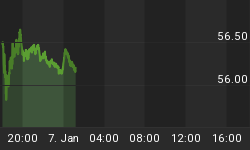In the old-school lexicon of Wall Street, the term "painting the tape" referred to the large scale purchase of market-moving stocks by insiders for the purpose of giving the market an appearance of strength. Painting the tape was practiced by "pools" and large firms who were in the know; it was designed primarily to present a picture of strength when there was an undercurrent of weakness. Painting the tape was also done in some cases to trick amateur traders into buying certain individual stocks by means of manipulating the stock's trading volume.
While the technique of "tape painting" has changed since those days, the practice of manipulating the market is still quite common. Indeed, it happens on a daily basis and successful speculation requires the ability to recognize it and deftly sidestep its intended consequences. That said, now would be an appropriate time to ask the question: "Is the market's recent internal strength the result of natural demand or of manipulation?" And if the latter is true, for what purpose is the market being given a false appearance of strength?
Let me begin by asserting that I don't believe the broad market's increasing strength since February is the result of outright deception. While there may be individual stocks, and perhaps even select industries, which are undergoing active manipulation the fact that the stock market's recovery is nearly six months old is an argument for legitimate demand-driven buying. Experience has taught that it's not possible to artificially strengthen a market for that length of time, especially when the NYSE new high-new low differential is so consistently strong. There must be broad-based demand, for no clique or coterie could possibly keep the entire market elevated for that length of time without widespread participation.
Having said that, I'll acknowledge the possibility that the recent breakout in the large cap indices may have been premature. While it was accompanied with great fanfare, the breakout to new highs was unaccompanied by some of the other major indices, including the Dow Transports and the NYSE Composite Index (NYA). The important financial sector stocks, moreover, remain stuck in their lateral trading patterns of the past year and didn't confirm the breakout, either.
If the tape is being painted, for what or for whom is the fireworks display being made? The most obvious culprit would be the upcoming U.S. presidential election. One possibility is that a large contingent on Wall Street is trying to influence the outcome of the November election. There's a well-known historical association which states that I the stock market rallies in the months before the election the incumbent party typically wins. The idea in fashion among Wall Street pros is that the Democrat nominee's policies would favor Wall Street. By contrast, there seems to be no clear consensus among pundits that the Republican nominee would be good for stocks.
A correlation has also been made between the periods of weakness in the financial market this year and the surges in candidate Trump's popularity. Trump has enjoyed his greatest campaign success when stocks have stumbled or remained subdued for long periods. An extended rally in the major indices, however, has coincided with a drop in his positive polling. There is, in other words, an inverse correlation between Trump and the prevailing stock market trend.
Again I must emphasize that this is merely a speculation on my part and cannot be empirically proven as a definite reality. If the new highs are being engineered for political or economic reasons, however, it will become clear in the months ahead. We'll know, for instance, if the new highs are artificially induced if the banking and broker/dealer stocks are unable to make yearly highs in the next few weeks. Failure of the Dow Transports to confirm the new high in Industrials would be another clue. In particular traders should keep a close watch on the chart of the NYSE Securities Broker/Dealer Index (XBD) shown below. The best and strongest extended bull markets have always been confirmed by higher highs in the XBD.

If the tape is indeed being "painted" then we can expect to see continued new highs in the Dow and SPX in the coming months, even if unconfirmed by the other indices and industry groups. Large cap stocks have been the beneficiaries of the informed buying of recent months and show no signs of being under distribution. Internal selling pressure within the NYSE broad market is nonexistent right now, which favors the bulls in their attempts at pushing large cap stocks higher before the election. There may, however, be a reckoning after the election is over.
In the meantime traders have some fantastic opportunities to take advantage of the favorable internal conditions within several of the market sectors. As a painter might say, one should never let a good canvas go to waste.
The Stock Market Cycles
For the summer months only, the book "The Stock Market Cycles" is available at a special discount to readers of this commentary. The book reveals the key to interpreting long-term stock price movement and economic performance, namely the famous Kress series of yearly cycles. This work was undertaken based on popular demand and was written in a style that casual readers and experts alike can enjoy and understand. The book covers each one of the yearly cycles in the Kress Cycle series, starting with the 2-year cycle and ending with the 120-year Grand Super Cycle.
The book also covers the K Wave and the effects of long-term inflation/deflation that these cycles exert over stock prices and the economy. Each chapter contains illustrations that show exactly how the yearly cycles influenced stock market performance and explains where the peaks and troughs of each cycle are located and how the cycles can predict future market and economic performance. Order your autographed copy today: http://www.clifdroke.com/books/Stock_Market.html















